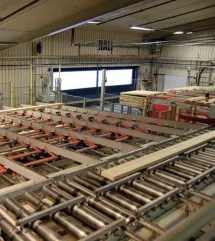
As the New Year begins, mixed feelings are running through the UK softwood trade, ranging from optimism to extreme caution.
While some merchants are optimistic that the government’s pledge to mass build will ensure an uplift in demand, others are dubious, citing skilled labour shortages and mortgage costs, which are still on the high side. Either way, all agree it is unlikely that demand will improve much during the first quarter, or even in the first half of the year.
Until the path ahead becomes clearer, many buyers are keeping a very tight rein on their inventory levels to retain as much liquidity in the business as possible. Merchants with re-processing facilities, such as planing and sawing equipment, are facing the additional burden of increasing energy tariffs. All timber distributors are battling against rising insurance costs, employers’ NI increased contributions and wage inflation. These factors are adding extra pressure to distributors already battling reduced trading margins due to vicious competition linked to weak demand.
In recent years, timber merchants have become wary of being warned of price increases due to log shortages and rising costs, only to witness the effects failing to materialise in the UK market. Instead, suppliers lost their resolve on many occasions and prices dropped back to the previous month’s levels, and yet the merchants still found what they needed from landed stocks.
So, it is not surprising that the latest message from producers of log shortages and price increases is being treated with some scepticism as buyers continue to feel that these suppliers are “crying wolf.”
This position has been repeated many times, over many decades, and merchants have learned the best policy against uncertainty is to hold back from buying until the last minute. As one merchant commented “a temporary shortage of stock is a lesser evil than being forced into stock write-downs”. While another agreed, “for a healthy and steady market to exist, suppliers need to be more certain of the information they pass on to their customers.”
Against this background, the market is likely to remain in a state of flux through January until the true state of supply becomes more visible, and the scale of demand can be ascertained.
Once again, shippers are talking of shortages and price rises through Q1, yet so far January prices look fragile, especially in the C24 market. To get some idea of whether or not these issues are likely to become a reality, it is pertinent to look at the position of the UK’s suppliers, and in particular the two largest exporters, Latvia and Sweden.
Taking Latvia first, sawmillers were shocked at the high cost of State logs at the November auctions. Several mill owners walked away without signing contracts as they knew it would be virtually impossible to make a return based on the price UK importers were prepared to pay.
For some, this was the first time a deal could not be struck with the State forestry, as to ship C24 into the UK, the production costs of converting the raw material would be higher than the price they could sell at. So, with this cutback of production in the pipeline, a shortage of Latvian carcassing can be expected in Q1, which is likely to stretch through Q2 as well.
To put Latvian supply into context, the country is the second largest supplier to the UK with a 16%-17% market share. It is estimated that UK imports in 2024 from Latvia were approximately 950,000m3, this figure will be confirmed as data is finalised over the next two months. The UK accounts for approximately 37% of Latvia’s total softwood exports and is their most important market.
Sweden is the largest supplier to the UK, holding first position and accounting for between 47%-48% of the UK market share. With closing figures still to be confirmed, the UNECE estimated that Sweden’s exports to the UK in 2024 would be 2,619,000m3 but actual volumes recorded (TDUK) up to the end of October point towards a higher figure closer to 2,679,000m3 which would be on a par with 2023. Sweden’s total softwood exports currently average 13.5 million m3, and around 20% of their volume is shipped to the UK.
Regarding the UK’s other main suppliers, the third largest is Finland. The Finns keeps a tight rein on production, which has been dropping since 2022 from around 11 million m3 down to 10,400,000m3. Total softwood exports for last year were estimated to be in the region of 8,200,000m3 from which around 700,000m3 were sent to the UK. During 2024, Finland was trending at a 12% share of Britain’s imports.
The two other significant supplying countries to the UK softwood market are Germany and the Irish Republic which are fairly evenly balanced volume-wise at 456,000m3 each. Both countries generally account for between 7%-8% each of UK market share.
Forecasts published by the UNECE for 2025 UK softwood consumption predict a rise from last year’s figure of 8,394,000m3 to 8,825,000m3. The total is made up from 5,862,000m3 of imports and 2,963,000m3* home-grown production (*accounting for exports).
Latvian production has been fairly consistent in recent times at approximately 2.5 million m3, but over the last year the product mix has noticeably moved away from structural grades to be replaced with other products such as rounded agricultural posts, landscaping products and pallet wood. These alternatives have increased because prices are more realistic for producers, and volume yields from raw materials are higher than those of C24.
Swedish supply has generally continued the traditional focus on whitewood construction material from the south, and the quality grades in redwood – (unsorted, 5th & 6th , or sawfalling) – from the middle to northern regions. While construction material has yielded little profit in the UK market, the demand for joinery and packing grades has remained consistent with relatively stable prices.
Although demand for structural grades has fallen short of expectations in the UK, many sources across Sweden are reporting shortages in whitewood at the mills, with some turning to a percentage of redwood in both C24 and CLS. One contact commented that this situation could affect the supply of joinery grades as this year progresses if demand for structural wood recovers and prices improve.
For 2025, several Swedish producers are scheduling more volumes towards other markets, particularly the US where returns have been showing a price upturn through regular increments. As the Swedes are experiencing higher demand from US buyers, they are committing larger whitewood volumes to the CLS market, which is the staple softwood product used in US house construction.
The recent strengthening of the US dollar has made European supply more attractive to North American buyers, and it has also given Swedish producers the chance to lift their kronor price at the mills while remaining competitive in the US market. The current exchange rate between the US dollar and Swedish kronor (SEK) is SEK11.279/1US$ (as of January 13), which is a dollar gain of almost 12% since the low recorded at end of Q2 last year on September 30 (10.0829).
There are some large exporters in Latvia who trade with the US market, and as the US dollar is also strong against the euro then the same opportunities are open. The euro is trading at €0.98/1US$, up from €0.89/1US$, showing an upward swing for the dollar of 10% since August last year.
Until recently, sterling has held a firm position on the currency exchange market, but started to edge down from January 9 against both the euro and kronor. Now trading at €1.189 and SEK13.689 respectively (on January 13) the pound has fallen 1.6% against the kronor and 1% against the euro since the last day of December 2024. While this is a small movement, economists are predicting GBP could become a stand-out casualty of global conditions and could continue to weaken, thereby pushing up the cost of imports. This situation is such that importers and merchants might do well to keep a close eye on the forward market, as prices can be quickly affected by sudden drops in sterling exchange rates.
In other softwood product types, demand for Canadian western red cedar (WRC) has remained strong in the UK through 2024 and as the trade goes into this year. Potential phytosanitary regulations requiring heat treatment certificates for the species caused a surge in volumes with rising prices in Q4 of last year. This change in regulation was to be activated at the end of January by the UK government, but after lobbying and plant health risk assessments by Canada Wood and TDUK, the requirement now appears to be cancelled for the particular species (Thuja).
American southern yellow pine is becoming the species of choice for laminated window profiles and stair components. As a stable and competitive product, it is easier to work into joinery batch productions and compensates for the lack of skills needed to process solid redwood and even some hardwoods. The market is said to be strengthening, with prices staying firm.
SUMMARY
Having survived a difficult 2024, traders want to feel enthusiasm and optimism for the year ahead in the belief that things can only get better. Nobody thinks it will be easy, and there is no doubt that everyone’s patience and resilience will be tested once again, perhaps to the limit. But the people of the timber industry believe in their product and its future as the sustainable solution to a healthy lowcarbon built environment.





